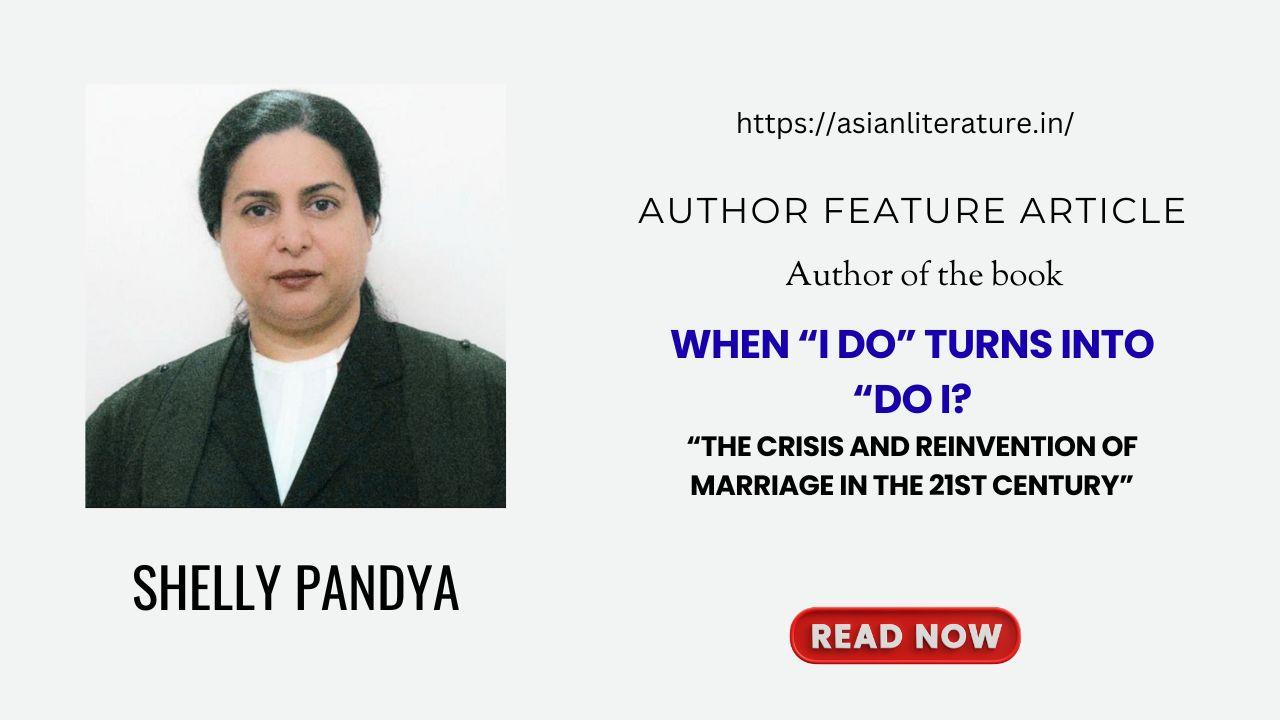
Discover why Shelly Pandya believes reforming marriage isn’t a threat to tradition — it’s the only way to save it.
In a world defined by constant technological disruption, where our professional lives move at the speed of fibre optics and our attention spans shrink under the weight of endless digital feeds, it seems inevitable that our most fundamental personal institution—marriage—would also be reeling. Yet, for too long, society has tried to fit the complex, evolving human needs of the 21st century into a rigid, century-old relationship framework.
This profound and often painful misalignment is the focus of Shelly Pandya’s groundbreaking new work, When “I Do” Turns into “Do I?”: The Crisis and Reinvention of Marriage in the 21st Century. More than just an analysis of societal trends, the book is a personal and professional reckoning, born from Pandya’s observation that the very foundations of partnership are crumbling under pressures they were never designed to withstand. This is the story of how a critical observer of human connection decided to write a manifesto for a new era of intimacy, arguing that the institution of marriage isn’t threatened by reform, but depends on it.
The Accelerated Revolution: From Generations to Five-Year Cycles
For Shelly Pandya, the genesis of When “I Do” Turns into “Do I?” wasn’t a single event, but a gradual, inescapable realization: the rate of change in human relationships has accelerated to a dizzying pace.
“Previously, there were slow generational changes witnessed by society,” Pandya observes in the book’s preface. “But now, every five years, of generational gap has exhibited a new revolution in relationships.”
This statement is the central thesis that drove the author to the page. It challenges the common narrative that modern marriage is simply struggling with “the usual stuff.” Instead, Pandya posits that couples today are navigating a constant, five-year refresh cycle of social norms, technological etiquette, and emotional expectations that their parents and grandparents faced over entire decades.
The competitive, hard-hitting, and stressful nature of modern life, amplified by relentless technological revolution and societal openness, means couples face novel pressures. The financial stability that often anchored previous generations is now replaced by professional instability; the privacy that defined domestic life is now invaded by social media and perpetual connectivity; and the lack of readily available, immediate information that forced commitment is now undercut by the effortless accessibility of alternatives and endless comparison.
Pandya recognized that this rapid, systemic change was manifesting as a crisis of confidence. The firm, historical certainty embedded in the phrase “I Do”—a certainty that presupposed a stable societal script, gender roles, and lifespan expectations—has dissolved into the hesitant, self-reflective anxiety of “Do I?”. It is the sound of an individual stopping mid-vow to question the very structure they are entering, not out of malice, but out of self-preservation and a more acute understanding of their own emotional needs.
The decision to write the book was, therefore, an act of intellectual intervention. It was clear that simply treating the symptoms—a higher divorce rate, generalized unhappiness—was insufficient. What was needed was a complete re-diagnosis of the disease itself: the structural inadequacy of the 20th-century marriage contract in a 21st-century world.
The Four Pillars: Identifying Necessities, Not Luxuries
In building the case for reinvention, Pandya meticulously outlines what a fulfilling, modern partnership requires. These are the elements that must be prioritized and protected, distinguishing them from the cultural baggage of tradition. The book distils these essentials into four non-negotiable pillars:
- Mutual Respect: Acknowledging and valuing a partner’s autonomy, desires, and personhood, especially as they evolve.
- Emotional Safety: Creating a space where vulnerability is not punished, and fear of judgment or abandonment is minimal.
- A Shared Goal: A collaborative vision for the future—whether a family, a specific lifestyle, or mutual career support—that transcends mere cohabitation.
- The Ability to Grow Together: Recognizing that both individuals are on a journey of continuous self-discovery, and the relationship must bend, not break, to accommodate that growth.
Pandya argues powerfully that “These are not luxuries; they are necessity.” They form the core infrastructure of a partnership built for fluidity and longevity in a dynamic environment.
The book delves into why these pillars are so fragile in the modern context. For instance, the demand for mutual respect is constantly tested by competitive career dynamics or the asymmetric burdens of domestic labour, which often fall along antiquated gender lines despite professional parity. Emotional safety is undermined by stress, external pressures, and the modern temptation to retreat into individual digital screens rather than engage in difficult, intimate conversation.
The path forward, according to Pandya, demands that couples move beyond simply “loving” one another and commit to actively safeguarding these four necessities. It’s an intellectual exercise as much as an emotional one, requiring both partners to become self-aware architects of their shared life.
The Structural Fault Line: Legislation, Culture, and the Professional Class
When “I Do” Turns into “Do I?” is not solely directed at couples; a significant portion of the book focuses on the external systems that currently regulate and often impede the modern marriage. Pandya issues a clear call to action aimed at legal institutions, professional counsellors, and society at large.
The systems surrounding marriage, the book argues, are often designed as “enforcers of old conventions” rather than “facilitators of healing and transformation.”
Legislation and Law: Pandya stresses that legal institutions must adapt by providing clarity, protection, and, critically, flexibility. Current legislation often forces couples into binary “in or out” legal structures that don’t account for the nuanced, complex, and sometimes temporary restructuring modern partnerships require. The book implicitly calls for a more flexible, perhaps tiered, legal recognition of intimate partnerships that protects assets and children without forcing an all-or-nothing approach to dissolution.
The Professional Class: Lawyers, counsellors, and mediators are challenged to evolve their practices. They must shift from adversarial roles, focused on assigning blame and dividing assets, to roles that prioritize resolution, emotional understanding, and mutual transformation. This requires a professional shift towards being guides through a challenging life transition, rather than agents in a legal battle. The goal is to move beyond mere division and towards a therapeutic and economic restructuring that preserves dignity and future health.
Cultural Narrative: Ultimately, the cultural narrative needs a radical update. Pandya champions the idea that marriage, “when done well, is a shelter rather than a trap.” The book’s message is one of empowerment: individuals must be empowered to make informed decisions, seek help when necessary, and honour their emotional limits without shame. This is a rejection of the cultural pressure that forces people to cling to a non-nurturing union simply because of tradition. Pandya’s powerful refrain is that “Tradition is not threatened by reform; rather, it depends on it.” Without reformation, the institution risks becoming entirely irrelevant.
The Circle of Marriage is a Spiral
Shelly Pandya’s most compelling philosophical contribution to the discussion is the concept of the “Circle of Marriage” being a spiral, not a complete loop.
In a traditional loop model, a couple faces challenges, resolves them, and returns to the exact same point in the relationship structure. There is no fundamental change, only repair.
In Pandya’s spiral model, the relationship alternates “between seclusion and camaraderie,” but critically, “each turn presents an opportunity to grow, learn, and love more wisely.” When a couple faces conflict—or even simple transition, like a career change or the arrival of a child—they do not return to their previous selves or their previous dynamic. They ascend to a higher level of maturity, having integrated the lessons of the challenge. The seclusion (individual reflection, personal growth) fuels the subsequent camaraderie (re-engagement, wiser love).
This perspective fundamentally redefines conflict. Conflict is not a failure of the loop; it is the necessary energy to propel the relationship upward on the spiral. It embraces the messy reality of human growth, where individuals are constantly changing and their relationship must constantly re-align.
This spiral philosophy is what makes When “I Do” Turns into “Do I?” an optimistic book, despite its frank examination of contemporary struggles. It is not mourning the end of traditional marriage; it is celebrating the birth of a more resilient, more self-aware, and more profoundly meaningful partnership for the 21st century.
A Call to Save Our Souls
In When “I Do” Turns into “Do I?”, Shelly Pandya has delivered an essential roadmap for navigating the complexities of modern love. It is a book that synthesizes sociological observation, emotional intelligence, and practical calls for systemic change.
The final pages leave readers with an unambiguous mandate:
- To redefine marriage in today’s environment.
- To reform the systems that regulate it.
- To embrace a future that values unity, self-awareness, and emotional truth in our most intimate relationships, rather than clinging to the past.
This is more than a book about weddings, divorce, or coupling; it is a profound inquiry into the nature of commitment itself in a volatile age. Pandya ultimately asks us to look inward and realize that to save our most intimate institutions, we must first save our individual souls, demanding honesty and continuous growth from ourselves and our partners. When “I Do” Turns into “Do I?” is the necessary guidebook for anyone seeking to build a love that endures, not by being rigid, but by being brave enough to evolve.
Shelly Pandya’s When “I Do” Turns into “Do I?”: The Crisis and Reinvention of Marriage in the 21st Century is available now from Evincepub Publishing.

